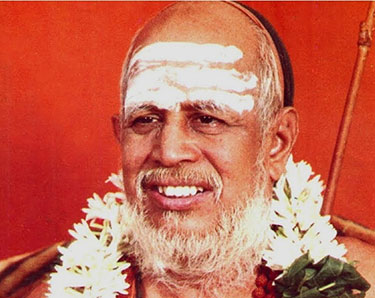
The past century had witnessed a steady decline in the interest of people to study, protect, preserve and propagate Indian culture and heritage. This is particularly true with respect to the Vedas. Several unique shakas, branches the Vedas were dwindling into non-existence.
To address this pressing issue, a charitable institution was formed under the instruction and guidance of Sri Jayendra Saraswathi Swamy. He says that a true disciple of this Vedic life or Veidica Dharmammuststrive to protect the Vedas.
It is said that this form of knowledge "THE Vedas" is protected by LORD BRAHMA. LORD MAHAVISHNU incarnated as BHAGAVAN VEDA VYASA in Dvapara Yuga and categorised it into four major branches. (shakas)
The whole of the Rig Ved The whole of the Rig Ved Samhita is in the form of verses. In later years, these verses came to be called slokas. It was originally called ‘Rik’ meaning a hymn in praise. The verses extoll the different Devatas. A number of Riks constitute a ‘Sookta’
It contains 10,170 verses or Riks. It contains 1028 ‘Sooktas’ or collection of hymns. The Rig Veda begins and ends with a ‘Sookta’ on Agni. This has led many to believe that the Veda propagates fire worship. However, it would be more correct to say the it refers to the light of the soul’s consciousness, aatma chiatanyam.
The last ‘Sookta’ has a very universal appeal expounding the following thought, “Let all men meet and think as one with one mind. Let all heart unite in love over a common goal. May all live in happiness with a common purpose”.
The word ‘Yajus” is derived from the word word “yaj” which means worship. It also connotes spelling out of ritualistic procedure. It primarily gives the hymns in Rig Veda a practical shape in the form of Yajna.
It has two main branches, Shukla meaning ‘white’ and Krishna meaning ‘black’. The glory of Yajur Veda lies in its good presentations of Vedic Karma or rituals. Yajur Veda is of particular significance to Advaitins – those who understand and believe in non-dualism. Sureswaracharya, a disciple of Adi Shankara wrote the Vaartika for Taittreeya and Brahadaaranayaka Upanishad from Krishna Yajur.
Saama means to bring Shanti or Peace to the minds, in short, make mind find happiness in peace. Saama refers to conquering of an enemy via love. Many of the mantras from Rig Veda are set to music in the Saama Veda. The music is greatly conducive for spiritual evolution of the self and the grace of the Gods.
In the Bhagavad Gita, Lord Krishna says that amongst the four Vedas, he is the Saama Veda. The Lalitha Sahasranaama, also describes Devi as Saamaganapriya, the one who is pleased by the recital of Saama Veda.
Atharva means a purohit. The mantras in Atharva Veda were brought to light by a Rishi called Atharvan. This Veda contains many types of mantras designed to ward off evil and hardship and destroy enemies. It is prose and verse. It refers to Devatas not mentioned in the other Vedas.
This Veda extolls the wonder of the creation of the universe in a hymn called Prithivi Sooktam. There are very few scholars of Atharva Veda. They are mainly in Nepal and Saurashtra. It is non-existent in South India.
There is a saying that one can attain Moksha only after learning the MaandukyaUpanishad in the Athrava Veda. This signifies its true importance.

The Jagathguru Sri Jayendra Sarswathi Trust was founded by Dr.G.K.Devarajulu, the late Chairman L.M.W. Group of Companies along with the family of Mr. Ravi Sam under the blessings of the Shankaracharya of Sri Kanchi Kamakoti Peetam in the year 1981. It was founded with the ambition to protect and resuscitate Vedic culture. The trust is Managed by the Board of Trustees and the day-to-day activities are looked after by the Secretary, Mr. Ravi Sam.
Narasimha jayanthi
Shankar jayanthi
Navarathri